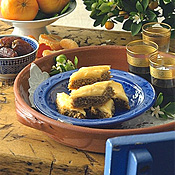|
|
Cuisine Glossary
| You have reached our International Cuisines and information on all aspects of a countries cuisine.
We will try to explain the culture, significant influences, climate, and other factors that have come together to create a distinct style. For example: Spanish, Mexican or Japanese. |
Armenian Cuisine
 |
Armenian cuisine is as ancient as the history of Armenia, and a wonderful combination of different tastes and aromas. Closely related to eastern cuisine, various spices, vegetables, fish, and fruits combine to present a unique experience for any visitor to the country.
Fruits such as peaches, apples, pears, cherries, mulberry, figs, pomengranates, strawberries and water melons are particularly succulent, but in particular, Armenia is famed for its apricots which many consider taste better than anywhere else in the world. A variety of natural juices and vodka are made from the many different types of fruits to be found in the country. Armenians like to eat bread with almost everything, and the two traditional types of bread in Armenia are lavash and matnakash. Lavash is a particular favorite -- flat bread rolled into circles and prepared in earthenware ovens in the ground (tonirs). Lavash is used to wrap Armenian cheese or meat spiced with onions, greens and pepper, and marinated before barbecuing over fire or in a tonir. Khoravadz is served with fried tomatoes, aubergines and peppers. There are also many different types of fish in Armenia, and Ishkan (trout) is considered particularly excellent. Dolma is also popular in Armenia, and there are two types. Summer dolma is meat stuffed into aubergines, pepper and tomatoes, while normal dolma is meat wrapped in vine or cabbage leaves, and served with matsuin (similar to yoghourt) and garlic. Kufte is made in different ways throughout the country, and Gavar kufte is made from minced meat spiced with onions and rolled into balls before boiling in water. Served in slices, it is garnished with butter. Khashlama is boiled meat and potatoes, and kebab is spiced minced meat cooked over a fire or in a pan. Harisa however, is a very ancient and traditional meal closely linked to Easter. Consisting of wheat and chicken, many families in Armenia still continue the tradition of serving harisa on Easter Day. Spas is a popular soup that consists of egg and flour stirred into matsoun, a sour diary product similar to yogurt. Other dishes for the more adventurous visitor to the country include Bastourma and Khash. Bastourma is dried slices of lean beef soaked in spicy chaman. Khash is scraped bovine shins, boiled in unsalted water until the flesh flakes off the bones. It is served hot with crushed garlic, and is eaten with lavash that is soaked in the bowl. Khash in particular, is a heavy meal that is not to everyone's taste, and is best eaten in the winter, early in the morning, and with a glass of vodka. Armenian cuisine is also rich in vegetable dishes and salads. In particular, aveluk, sibekh, spitakuk and shrest are boiled before frying with onions and eggs, and made into soups and salads. Aveluk and other vegetarian dishes are served with nuts and matsoun. Source: HungryMonster Writers |




